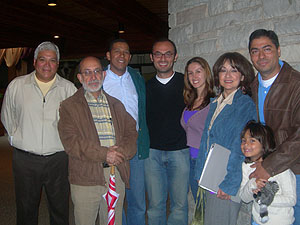The challenge of speaking Spanish in America
If you listen to a group of native Spanish-speakers, you might think their fast-paced conversation means easy communication with one another. But within the Spanish-speaking population, there's a very clear divide -- a linguistic "us" and "them."
St. Paul, Minn. — On a Sunday afternoon at St. Odilia Catholic Church in Shoreview, a group of Latin Americans chat with me after Mass. They've come to the United States from six different countries.
Each person here speaks Spanish. but immediately the differences are evident. Jorge Rodriguez from Mexico says those differences are actually quite comical.
"It's really entertaining," says Rodriguez. "It's unbelievable that even among ourselves, we need translators!"
They need translators because Spanish isn't just Spanish. It's different from one country to another. Words have different meanings. Accents and variations in grammar make Spanish speakers listen carefully to each other.
Sometimes people will even give each other disclaimers, "Hey, I'm from Puerto Rico," just to give other Latinos a heads up.
Diego Reyes, who's from Colombia, studied in Mexico for a few years. He was his wife's translator any time she would visit him.
"The phrase, 'en bola' in Mexico means, 'As a group.' But in Colombia, the phrase 'en bola' means to be naked," says Reyes. "So people would say, 'Let's go to the stadium EN BOLA.' I'd have to tell her, 'No, that means we're going to the stadium as a group, not naked.' It's small things like that that change the context of the conversation."
There are differences in pronunciation, too, that can immediately give away where a Latino is from. For example, sometimes Puerto Ricans struggle to pronounce the letter R. Instead of rolling the R, it comes out as an L.
People from Caribbean nations and Central America often don't enunciate the "S" when it comes at the end of a word or syllable. It's what Francine Acosta learned in her native country Puerto Rico. She aspirates her "S" when she says Spanish words, like "esto."
Spanish can even be different within a single country. In Peru, indigenous people, who speak their native language Quechua, have a different accent when they speak Spanish. Their Spanish dialect is seen as less prestigious.
Carol Klee, a sociolinguist and professor at the University of Minnesota, says Spanish from the Colombian capital of Bogota is often seen as the most prestigious Spanish because it's traditional. Unlike other Spanish dialects, it's gone through the least amount of changes in terms of pronunciation and grammar. But Klee says it's all relative.
"The way dialects are viewed, and the prestige of different dialects, depends on the prestige of the speakers of those dialects," says Klee. "It's very closely related to educational level, it's related to economic development and social class, it's often times related to race and ethnicity."
Does that mean one country's Spanish is better than another? Diego Reyes says between friends, it doesn't matter what kind of Spanish you speak. Outside of that, it's a different story. He recalls speaking his Colombian Spanish while studying in Mexico.
"When you're in an academic or competitive environment, then you'll find that attitude," says Reyes. "So in Mexico, I spoke differently and people would say, 'Well, it's because you speak Spanish poorly.'"
As Reyes talks, his wife Alexandra Ramirez jumps in. She says comparing the quality of language dialects is universal.
"It's the same idea that British English is the real English," says Ramirez. "I studied British English and I found that attitude, too. American English is not English. It's poorly pronounced, poorly spoken. It's the same thing."
Latin Americans not only have to work around differences in pronunciation, grammar, and vocabulary, they also have to deal with Spanglish. This Spanish-English blend is a phenomenon that often occurs in U.S. border states and large bilingual communities.
Spanglish, much like Spanish itself, is different from location to location. The Spanglish spoken in the San Antonio differs from the way it's spoken in Miami or New York City.
The hybrid language is a new challenge for native Spanish speakers like Carlos Duque from Colombia. He says he finds it difficult to communicate with Latinos in the U.S.
"The majority of Spanish-speakers in the U.S. speak Spanish with a blend of English words," says Duque. "It's difficult to understand depending on the level of their education, or whether or not they are also blending in regional jargon from their countries. So I end up asking, 'Could you repeat yourself please?' or 'Excuse me, I speak Spanish, but I don't understand you.'"
Duque says he recognizes how much schooling a person's had as soon as they open their mouth. Within minutes, he can tell the quality of their Spanish skills.
Speakers of Spanglish, or Spanish with an American accent, often feel stigmatized by those who speak a more traditional Spanish dialect.
Speaking Spanish well is important to many Latinos because it's a big source of their identity. But Klee says although language can be closely tied to identity, it doesn't always have to be.
"Speakers of more stigmatized dialects within the Latino community will shift more rapidly to English, rather than speaking a dialect others look down on," says Klee.
Klee says Puerto Ricans in New York have a strong Latino identity, even though some of them may not necessarily be fluent in Spanish.
Every language has its dialects. But new Spanish-speaking immigrants face the challenge of learning both English and Spanglish to connect with one another. It's a never-ending linguistic challenge for new immigrants.
Although many feel like this hybrid dilutes Spanish, more Latinos are starting to accept Spanglish as a new form of communication and a new way to define themselves in the U.S. The Spanglish influence is so strong, it's even trickling into Latin America. [....snip] Minnesota Public Radio




No comments:
Post a Comment